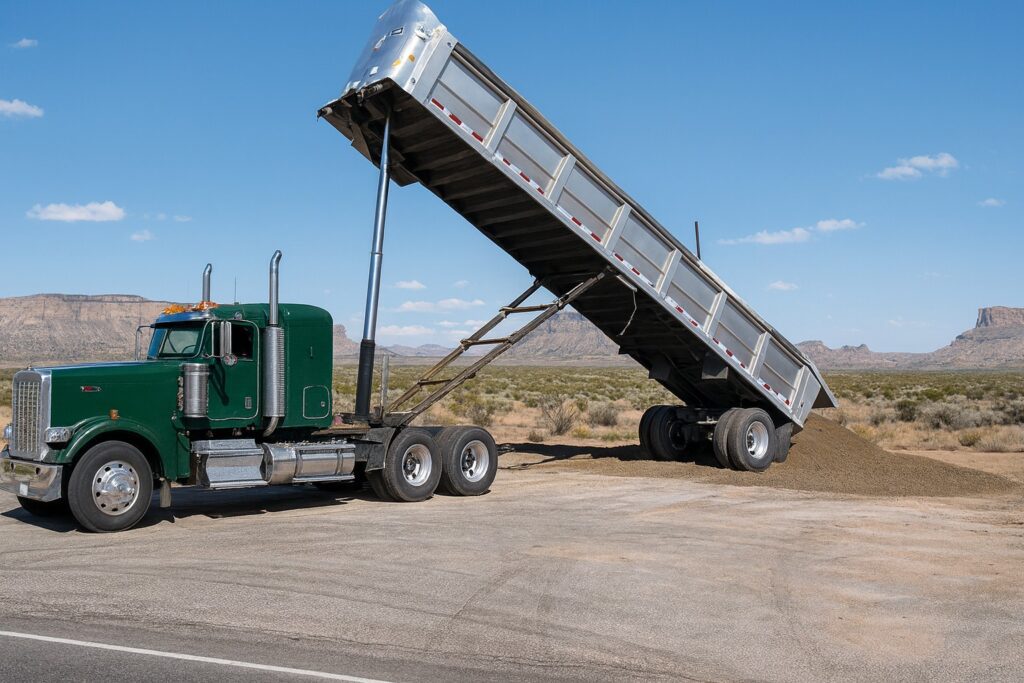A dump trailer compresses labor, shortens cycle times, and raises throughput on small and mid-scale hauling work. Crews load fast, travel safely, and tip the bed in seconds. You move demolition debris, roofing tear-offs, mulch, soil, aggregate, scrap, and farm material without tying up a full dump truck. If your routes include narrow streets, alleys, or gates, a dump trailer gives you capacity with precise control at the job site.
How a dump trailer works
Hydraulics do the lifting. A deep-cycle battery powers a pump that feeds either a scissor hoist, a single-ram, or a telescopic cylinder. Scissor geometry multiplies leverage at high dump angles.
Telescopic cylinders save weight while reaching steep angles on longer beds. Most controllers offer wired and wireless options, so operators stand clear during the dump. A proper trailer includes a bed prop or mechanical lockout for safe service and inspection.
Core configurations and hitch choices
Pick the hitch that matches the weight and maneuvering needs. A bumper pull setup hitches to a receiver, keeps overall length short, and threads through tight neighborhoods. A gooseneck shifts weight forward, increases stability at highway speed, and improves turning precision with heavy loads.
Bed sizes vary widely. Common lengths run 10 to 16 feet, with widths from 72 to 83 inches. Side heights range from 18 to 48 inches. Side boards boost volume for low-density loads like brush and mulch.
Tandem 7K or 8K axles cover most contractors. Tri-axle packages increase payload and smooth braking. Choose heavy-duty frames with boxed tube main rails, full-length bed sills, and integrated stake pockets and D-rings.
When a dump trailer beats a dump truck
Use a dump trailer when you want lower acquisition cost, lower insurance, and simpler storage. One tow vehicle can pull different bodies through the week and pivot to other work on weekends.
Tight sites reward a shorter wheelbase and a lower bed.
Crews stage close to the pile, feather the dump, and place the load exactly where it belongs. This allows you to maintain operating flexibility without the overhead of a dedicated dump truck.
Materials, durability, and corrosion control
Match construction to impact and environment. Abrasion-resistant steel floors and thicker sidewalls absorb rock and concrete without denting. Where salt and moisture attack, galvanization and high-quality powder coat slow rust. Rinse the frame and underbody after winter runs.
Aluminum sheds corrosion in coastal regions and trims trailer weight, but steel absorbs abuse better on heavy impact cycles. Electrical integrity matters as much as metal choice. Demand sealed harnesses, grommeted pass-throughs, and recessed LED lighting. Select trailers that meet DOT lighting and conspicuity rules and protect wiring from chafe and stone spray.
Power, brakes, and running gear
Size the hydraulic system to the real payload, not brochure numbers. A high-output charger and healthy battery keep cycle times short across a full workday.
Equip electric-over-hydraulic brakes for long grades and mixed traffic. Radial tires run cooler and last longer than bias ply in urban stop-and-go.
Confirm GAWR and tire load indexes against your heaviest day, not your average day. Align axle spreads and spring packs with local bridge formulas so your rig scales cleanly.
Features that return a value fast
Time-saving options pay for themselves. A contractor-grade trailer includes a tarp system that keeps debris contained and keeps inspectors happy.
Barn-door gates swing wide for skid-steer loading. Spreader gates meter gravel down a drive with clean edges.
Under-bed or front tool boxes protect straps, chains, binders, and chargers. Full-length rub rails accept winches and protect side panels. Add a bed liner to reduce hang-ups with wet clay and to preserve coatings. Many operators add a solar maintainer so the battery stays ready between jobs.
Capacity, compliance, and honest numbers
Read the plates and do the math. The GVWR sets the legal maximum for the trailer. The curb weight tells you the empty figure. The payload equals GVWR minus curb weight.
Confirm tongue weight stays within receiver limits on bumper pull units. When you load dense material like crushed stone or wet soil, scale the combination. Water adds pounds fast and exceeds axle ratings before you notice. Select trailers that meet your state bridge and axle limits and match your typical routes.
Loading and dumping technique
Control risk through methodical staging. Park on firm, level ground. Chock the wheels before you lift the bed. Load dense material first and tightly against the bulkhead, then distribute weight across the floor.
Pack branches and scrap so nothing shifts near the hinge line. Raise the bed slowly while you watch for hang-ups. Lower the bed and adjust if material sticks rather than rocking the trailer. Drop the bed, secure latches and pins, and run a final walkaround before you exit the job site.
Economics that favor small crews
A dump trailer often delivers the best cost curve for solo operators and small teams. You spend far less than a truck and avoid specialized service networks. You also increase asset utilization because the tow vehicle can work on other assignments when the trailer is unused.
Disciplined service can keep uptime high. Charge the battery, grease hinge pins and hoist pivots, torque lug nuts, inspect brake linings, and replace tires before cords show. Routine care protects resale value and shortens the total cost of ownership.
Who gains the most
Landscapers cycle mulch and soil all day without bottlenecks. The roofer’s stage is close to the tear-off, cutting ladder time. Concrete crews spread gravel through a metered gate with clean edges.
Farmers move feed, bedding, and fencing without tying up a tractor on the road. Municipal teams clear storm debris with a compact footprint that fits alleys and parks. These use cases span a wide range of trades because the platform adapts to the work, not the other way around.
Buying checklist
- Define your primary material and weight per cubic yard.
- Size bed length and side height for volume, not just footprint.
- Choose scissor, single-ram, or telescopic hoist and confirm dump angle.
- Pick bumper pull or gooseneck based on weights, turning room, and storage.
- Match axle ratings, brakes, and tire load indexes to the heaviest day.
- Specify heavy duty frame members and sealed wiring with recessed LEDs.
- Add time savers: tarp kit, barn-door and spreader gates, ramps, tool boxes, and bed liner.
- Set a maintenance schedule and assign accountability.
Learn more before you commit
If you want to compare platforms across use cases, read Trailer Types Explained: Choosing the Right One. This guide places a dump trailer next to flatbeds, step decks, and other types. This helps you match the platform shape with the cargo, route, and loading method.
Bottom line
Choose a dump trailer when you want fast cycles, precise placement, and strong value without the burden of a dedicated dump truck. Size the box to your material, match the hoist capacity to the real payload, and select the hitch that fits your routes. When you match capacity, features, and compliance with daily tasks, you do more with less effort. This leads to less downtime and better profits.

